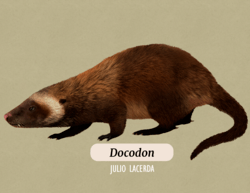Docodonta
| Docodonts Temporal range: Middle Jurassic–Early Cretaceous | |
|---|---|
 | |
| Life restoration of a Docodon | |
| Scientific classification | |
| Kingdom: | Animalia |
| Phylum: | Chordata |
| Clade: | Synapsida |
| Order: | Therapsida |
| Suborder: | Cynodontia |
| Clade: | Mammaliaformes |
| Clade: | †Docodonta Kretzoi, 1946 |
| Genera | |
| |
Docodonta is an order of extinct mammaliaforms that lived during the mid- to late-Mesozoic era. Their most distinguishing physical features were their relatively sophisticated molar teeth, from which the order gets its name. Until recently, Docodonta were represented primarily by isolated teeth and bits of jawbones, with most of these specimens found across former Laurasia (modern-day North America, Europe, and Asia). One disputed docodont has been described from Gondwana (modern-day India and Southern Hemisphere).[1] However, recent discoveries in China have included some exceptionally well preserved, almost complete body fossils[2][3]
Docodonts were traditionally thought to have been primarily ground dwelling and insectivorous, but Castorocauda[4] and possibly Haldanodon[5][6] were specialised for a semi-aquatic lifestyle. Castorocauda also had recurved molars, which suggests possible fish or aquatic invertebrate diet, and a flattened tail.[4] It was thought likely that many docodonts had tendencies towards semi-aquatic habits, given their presence in wetland environments.[7] However, recent discoveries such as the specialised digging species Docofossor,[2] and specialised tree-dweller Agilodocodon[3] suggest Docodonta is more ecologically diverse than previously suspected. Docofossor shows many of the same physical traits as the modern day golden mole, such as wide, shortened digits in the hands for digging.
Taxonomy
Docodonts are not as closely related to the placentals and marsupials as the monotremes, and are not included in the crown-group mammals. The complexity of their molars and the fact that they possess the dentary-squamosal jaw joint, means that they were previously sometimes regarded as belonging to Mammalia. Some authors limit the term "Mammalia" to the crown group, which excludes mammaliaforms like the docodonts. They are considered to be closer to Mammalia than many other early mammalian groups such as Morganucodonta, Kuehneotheriidae, Haramiyida and Sinoconodon.
- Order †Docodonta Kretzoi 1958 sensu Kielan-Jaworowska, Cifelli & Luo 2004[8][9]
- Family †Docodontidae (Marsh 1887) Simpson 1929
- †Agilodocodon scansorius Meng et al. 2015[3]
- †Borealestes Waldman & Savage 1972
- †B. serendipitus Waldman & Savage 1972[10]
- †B. mussetti Sigogneau-Russell 2003
- †Castorocauda lutrasimilis Ji et al. 2006[4]
- †Docodon Marsh 1881 [Dicrocynodon Marsh 1880; Diplocynodon Marsh 1880 non Pomel 1847; Ennacodon Marsh 1890; Enneodon Marsh 1887 non Prangner 1845; Dryolestes Marsh 1879]
- †D. apoxys Rougier et al. 2014(Marsh 1880) Marsh 1881 [Dicrocynodon victor Marsh 1880; Diplocynodon victor Marsh 1880]
- †D. striatus (Marsh 1880) Marsh 1881 [Dicrocynodon striatus Marsh 1880]
- †D. affinis (Marsh 1887) [Enneodon affinis Marsh 1887]
- †D. crassus (Marsh 1887) [Enneodon crassus Marsh 1887; Ennacodon crassus (Marsh 1887)]
- †D. superus Simpson 1929 [Dicrocynodon victor Marsh 1880]
- †Docofossor brachydactylus Luo et al. 2015[2]
- †Dsugarodon zuoi Pfretzschner et al. 2005 [Acuodulodon Hu, Meng & Clark 2007; Acuodulodon sunae Hu, Meng & Clark 2007]
- †Haldanodon exspectatus Kühne & Krusat 1972 sensu Sigoneau-Russell 2003[5]
- †Hutegotherium yaomingi Averianov et al. 2010
- †Itatodon tatarinovi Lopatin and Averianov 2005
- †Krusatodon kirtlingtonensis Sigogneau-Russell 2003
- †Paritatodon kermacki Martin and Averianov 2010
- †Peraiocynodon Simpson 1928
- †Peraiocynodon inexpectatus|P. inexpectatus Simpson 1928
- †Peraiocynodon major|P. major Sigogneau-Russell 2003
- †Sibirotherium rossicus Maschenko, Lopatin & Voronkevich 2002
- †Simpsonodon Kermack et al. 1987
- †S. splendens (Kühne 1969) [Cyrtlatherium spendens (Kühne 1968) emend Averianov et al. 2010]
- †S. sibiricus Averianov et al. 2010 [Cyrtlatherium sibiricus (Averianov et al. 2010)]
- †Tashkumyrodon desideratus Martin & Averianov 2004
- †Tegotherium gubini Tatarinov 1994
- †Cyrtlatherium canei Freeman 1979 sensu Sigogneau-Russell 2001 [Simpsonodon oxfordensis Kermack et al. 1987]
- †Gondtherium dattai Prasad & Manhas 2007[1] (contested whether this is a docodontid)
- †Reigitherium bunodontum Bonaparte 1990 (considered to be a dryolestid by some authors[11])
- Family †Docodontidae (Marsh 1887) Simpson 1929
See also
References
- 1 2 Prasad, G. V. R., and B. K. Manhas. 2001 First docodont mammals of Laurasian affinities from India. Current Science, 81:1235-1238.
- 1 2 3 Luo, Z., Meng, Q., Ji, Q., Liu, D., Zhang, Y., Neander, A. I. 2015 Evolutionary development in basal mammaliaformes as revealed by a docodontan. Science, 347, 6223, 760-764
- 1 2 3 Meng, Q., Ji, Q., Zhang, Y., Liu, D., Grossnickle, D. M., and Luo, Z. 2015 An arboreal docodont from the Jurassic and mammaliaform ecological diversification. Science, 347, 6223, 760-764.
- 1 2 3 Ji, Q., Luo, Z., Yuan, C. and Tabrum, A. R. 2006 A swimming Mammaliaform from the Middle Jurassic and ecomorphological diversification of early mammals. Science, 311, 1123-1127.
- 1 2 Kühne W. G. and Krusat, G. 1972. Legalisierung des Taxon Haldanodon (Mammalia, Docodonta). Neues Jahrbuch für Geologie Monatshefte 1972:300-302
- ↑ Krusat, G. 1991 Functional morphology of Haldanodon exspectatus (Mammalia, Docodonta) from the Upper Jurassic of Portugal. Fifth Symposium on Mesozoic Terrestrial Ecosystems and Biota.
- ↑ Paleontology and Geology of the Upper Jurassic Morrison Formation: Bulletin 36
- ↑ Mikko's Phylogeny Archive Haaramo, Mikko (2007). "Docodonta - docodonts". Retrieved 30 December 2015.
- ↑ Paleofile.com (net, info) "Archived copy". Archived from the original on 2016-01-11. Retrieved 2015-12-30.. "Taxonomic lists- Mammals". Retrieved 30 December 2015.
- ↑ Waldman, M and Savage, R.J.G 1972 The first Jurassic mammal from Scotland. Journal of the Geological Society of London 128:119-125
- ↑ Rougier, G. W., and Apesteguia, S. 2004 The Mesozoic radiation of dryolestids in South America: dental and cranial evidence. Journal of Vertebrate Palaeontology, 24 (Supplement to No. 3):106A.
- G. V. R. Prasad and B. K. Manhas. "First docodont mammals of Laurasian affinity from India". Current Science. November 10, 2001.
